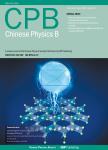Effect of driving frequency on electron heating in capacitively coupled RF argon glow discharges at low pressure
Effect of driving frequency on electron heating in capacitively coupled RF argon glow discharges at low pressure作者机构:Key Laboratory of Materials Modification by Laser Ion and Electron Beams Ministry of Education School of PhysicsDalian University of Technology School of Information Science and Engineering Dalian Polytechnic University School of Materials & Metallurgy University of Science & Technology
出 版 物:《Chinese Physics B》 (中国物理B(英文版))
年 卷 期:2017年第26卷第11期
页 面:329-337页
核心收录:
学科分类:080901[工学-物理电子学] 0809[工学-电子科学与技术(可授工学、理学学位)] 08[工学] 082502[工学-航空宇航推进理论与工程] 0805[工学-材料科学与工程(可授工学、理学学位)] 0704[理学-天文学] 0825[工学-航空宇航科学与技术]
基 金:Project supported by the National Natural Science Foundation of China(Grant No.51172101)
主 题:capacitively coupled plasmas electron heating radio frequency(RF) glow discharges driving frequency
摘 要:A one-dimensional(1D) fluid model on capacitively coupled radio frequency(RF) argon glow discharge between parallel-plates electrodes at low pressure is established to test the effect of the driving frequency on electron heating. The model is solved numerically by a finite difference method. The numerical results show that the discharge process may be divided into three stages: the growing rapidly stage, the growing slowly stage, and the steady stage. In the steady stage,the maximal electron density increases as the driving frequency increases. The results show that the discharge region has three parts: the powered electrode sheath region, the bulk plasma region and the grounded electrode sheath region. In the growing rapidly stage(at 18 μs), the results of the cycle-averaged electric field, electron temperature, electron density, and electric potentials for the driving frequencies of 3.39, 6.78, 13.56, and 27.12 MHz are compared, respectively. Furthermore,the results of cycle-averaged electron pressure cooling, electron ohmic heating, electron heating, and electron energy loss for the driving frequencies of 3.39, 6.78, 13.56, and 27.12 MHz are discussed, respectively. It is also found that the effect of the cycle-averaged electron pressure cooling on the electrons is to "cool" the electrons; the effect of the electron ohmic heating on the electrons is always to "heat" the electrons; the effect of the cycle-averaged electron ohmic heating on the electrons is stronger than the effect of the cycle-averaged electron pressure cooling on the electrons in the discharge region except in the regions near the electrodes. Therefore, the effect of the cycle-averaged electron heating on the electrons is to "heat" the electrons in the discharge region except in the regions near the electrodes. However, in the regions near the electrodes, the effect of the cycle-averaged electron heating on the electron is to "cool" the electrons. Finally, the space distributions of the electron



